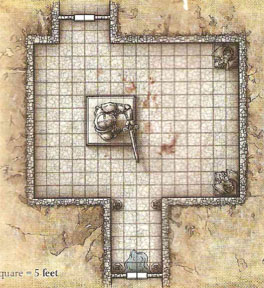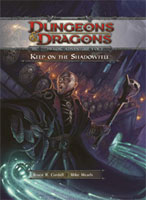The following thoughts contain minor spoilers for Keep on the Shadowfell. If you don’t want to be spoiled, don’t read it. And if you’re in my gaming group then you definitely shouldn’t be reading it.
TRAPS IN 4th EDITION
One of the features of 4th Edition that has been widely touted in WotC’s promotional material have been the new trap design focusing on active traps. Basically, the argument is made that traditional traps either (a) suck up a lot of time because they encourage players to make constant Search checks; (b) are nothing more than random dice rolls that deal out arbitrary damage; and/or (c) focus the spotlight on the player of the rogue while everyone else sits around twiddling their thumbs. The new 4th Edition-style traps will allow everyone in the party to participate in overcoming the trap.
This seems like a laudable goal, but the actual examples we were given turned out to be fairly lackluster. They still required skill checks to detect them. They were slightly more interactive than a simple pit trap, but were pretty tame compared to some of the stuff we saw in the Book of Challenges (a 3rd Edition supplement that came out back in 2002), Traps & Treachery (a D20 supplement from Fantasy Flight Games that came out in 2001), or Grimtooth’s Traps (an entire line of supplements that date back to 1981).
(Which ties into one of the reasons I’ve been perpetually turned off by the 4th Edition preview material. They seem to be constantly shouting about how they’ve reinvented the wheel. I like wheels as much as the next guy, but when somebody asks me to get excited about them I tend to get turned off by the fake enthusiasm.)
As for the effort to make traps into something that everybody can take part in, that seems to have boiled down to: The rogue makes a lot of skill checks and, if that doesn’t work, then everybody else can beat the crap out of it.
For example, here’s the countermeasures for the Whirling Blades trap (the first example of their “innovative” 4th Edition traps):
- A character can engage in a skill challenge to deactivate the control panel. DC 22 Thievery. Complexity 2 (6 successes before 3 failures). Success disables the trap. Failure causes the whirling blades to act twice in the round (roll a second initiative for the trap).
- A character can attack the whirling blades contraption (AC 16, other defenses 13; hp 55; resist 5 all) or the control panel (AC 14, other defenses 11; hp 35; resist 5 all). Destroying either disables the entire trap.
Color me unimpressed. I mean, there’s nothing wrong with that. But when you claim that one of the fundamental gameplay elements of D&D for the past 30+ years have “rarely had a positive effect on the game”, then the examples you give of “fixing” the “problem” probably shouldn’t look exactly like the stuff we’ve been seeing in our D&D supplements for the past 30+ years.
THE CHAMBER OF STATUES
 Keep on the Shadowfell has a couple of traps: There’s a bog standard pit trap. There are some runes that cause characters to flee in panic. And then there’s Area 16: The Chamber of Statues.
Keep on the Shadowfell has a couple of traps: There’s a bog standard pit trap. There are some runes that cause characters to flee in panic. And then there’s Area 16: The Chamber of Statues.
The Chamber of Statues is a two-part trap, but I’m only going to be talking about the first part. In this section there are three statues, starting with a large titan statue in the middle of the room which acts like a monster. On its initiative it uses its sweeping blow ability:
SWEEPING BLOW (standard; at will)
Close burst 3; +11 vs. AC against all non-Evil creatures in burst; 1d6+6 damage, and the target is knocked prone
In other words, the titan statue picks a square in either its own space or immediately adjacent to its space. That square is the center of an 7-square by 7-square area. It then makes an attack against all non-Evil creatures within that area.
The titan statue is accompanied by two dragon statues, each of which use a force breath ability:
FORCE BREATH (standard; at will)
Close blast 5; +7 vs. Reflex; 1d6+6 force damage, and the target is pushed 3 squares
In other words, if you try to circle around the titan statue’s reach the dragon statues will hit you with their force breath and push you back towards the titan statue. It’s a simple dynamic, but it has a lot of potential to be fun in play. Unfortunately, there are several design problems here.
THE WALK AROUND: One of the ways you can work your way through the trap is to make an Athletics check to jump onto the statue. This allows you to avoid the titan statue’s attacks. So you could potentially jump onto the statue, avoid its attacks, jump off the other side and head to safety on the other side of the room (without ever getting close enough to the dragon statues to get targeted by their force breath).
The problem is that there’s absolutely no reason to do that: You can simply walk right past the entire trap. Why? The titan statue’s sweeping blow isn’t triggered as a reaction — its an action taken on the titan statue’s initiative. Nor does the titan statue have reach (which would allow it to take opportunity attacks). That means, once the titan statue makes its first attack, everyone is free to walk right past it.
LACK OF COOPERATION: As with the sample traps posted on WotC’s website, this trap features the ability to either whack on it or disable it. This theoretically opens up a bit more interactivity than the website samples because, in this trap, there are multiple targets that aren’t dependent on each other: The thief could be working on the titan statue while the other characters are whacking away on the dragon statues.
Only that isn’t actually true, because there’s no reason to go anywhere near the dragon statues (even if you don’t simply walk right past the entire trap): If you stick to the west side of the titan statue you’re completely out of their range.
LACK OF COOPERATION 2: This trap also introduces the ability for non-Thievery checks to disable traps: The dragon statues (but not the titan statue) can be disabled by either four successful Thievery checks or six successful Arcana checks.
Setting aside the fact that disabling the dragon statues is completely irrelevant, there’s a deeper design problem here: The Thievery and Arcana checks can’t be used in conjunction with each other. Either you disable the trap using Thievery checks or you disable the trap using Arcana checks — you can’t mix-and-match.
Based on other traps in the adventure, this seems to be a frequent (but not required) feature of magic-based traps. However, it always requires more Arcana checks than Thievery checks, which means that you’ll always see the exact same dynamic in play with traps of this type: The guy with the Thievery skill will try to disable the trap. If he fails, the guy with the Arcana skill will try to disable the trap.
This doesn’t actually make the trap any more interactive, nor does it actually get more players involved in the process. (At any given time, there’s still just one guy making skill checks.) It just means that the entire thing takes more time and becomes a lot more monotonous.
WotC claims that one of the problems with traps in 3rd Edition was that the rogue made a Disable Device check while everyone else sat around and watched him. So explain to me how this is “fixed” by giving us a trap in which the rogue makes 6+ skill checks in order to disable the trap while everybody else stands around watching them work?
(Why 6+ checks? An Athletics check to jump up on the statue. A Perception check (DC 25) to find the access panel. And then at least four Thievery checks to disable the statue. So it will take a minimum of 6 checks, but given the probable skill modifiers of the pregenerated rogue PC they’ll probably be making 9 or 10 checks in total.)
JUST BEAT THE CRAP OUT OF IT: But none of what I’ve described actually matters because none of these statues can move and none of them have relevant ranged attacks. This means that the PCs will stay in the safe area by the northern door and use their ranged attacks to whittle away at the titan statue’s hit points.
THE BOTTOM LINE
So this entire elaborate trap which, at first glance, appears to be filled with interesting possibilities, will, in fact, be resolved in one of three exceptionally boring ways:
(1) One of the PCs will suffer 1 or 2 attacks from the statue and then they’ll all walk out of the room.
(2) The rogue will make a half dozen or more skill checks and then they’ll all walk through the room.
(3) The PCs will engage in the most boring combat imaginable: Standing where the opponent can’t possibly hurt them, the players will repetitively roll dice until they finally manage to rack up the magic number and can walk through the room unimpeded.
I honestly don’t understand how such a lackluster encounter got designed. I also don’t see how it could have possibly been playtested without such fundamental design errors being exploited by the playtesters. (And if it was playtested and the playtesters exposed its flaws, why weren’t they fixed?)
Tomorrow I fix it.












